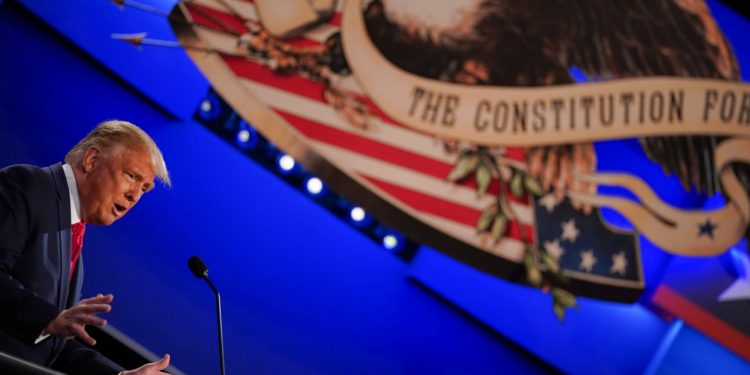The second and final debate between President Donald Trump and Democratic challenger Joe Biden on Thursday was far more civil. The two interrupted each other far less frequently.
At the second debate, Trump was on his best behavior early.
Before, in the first presidential debate, it was so panned so widely that organizers introduced a mute button.
At that time, the two clashed on issues ranging from the coronavirus to crime. Especially with the moderator, whom he’d repeatedly attacked before the debate.
Because of the pandemic, only around 200 people were seated inside the debate hall in the massive college arena in Nashville. That included a representative of the Commission on Presidential Debates, who was tasked with ensuring each candidate had a two full minutes of uninterrupted time to deliver opening answers on six major topics, according to debate commission chair Frank Fahrenkopf.
And it seemed to be working, at least during the debate’s opening questions. While Trump and Biden each shook his head disapprovingly during the other’s answer about the pandemic, there was minimal interruption. And neither man tried to speak while he was muted during the opening questions.
A member of each of the Trump and Biden campaigns monitored the person who controlled the mute button backstage, Fahrenkopf told The Associated Press, noting that the button would not be used beyond the first four minutes of each topic.
The button was among a handful of changes implemented by the nonpartisan debate commission to help ensure a more orderly debate following the raucous and widely criticized opening debate 23 days ago.
As we know, Trump was diagnosed with COVID-19 two days after the event. And for this time,Trump was given a test aboard Air Force One en route to Nashville Thursday and tested negative, as cited News24xx.com from the White House chief of staff Mark Meadows.
Biden’s campaign reported he also tested negative.
Organizers initially planned to separate the candidates with plexiglass barriers, but removed them hours before the debate began.
Trump campaign official said the decision was made after Meadows called Anthony Fauci, the nation’s highly respected top infectious diseases expert, during a walkthrough of the venue site.
Meadows them put Fauci on speakerphone, and Fauci told those in the room that all it would do was provide a false sense of security, the person said.
Additionally, any audience member who refused to wear a mask would be removed.
Last month, several members of the Trump family removed their masks once seated in the debate hall, but were allowed to stay.
This time, Melania Trump, who was appearing in public for the first time since her own diagnosis with the virus, was seen in her seat wearing a mask.
Before the debate began, Fahrenkopf repeated the instruction to the small audience.
Only around 200 people were allowed inside, a mix of invited guests of the campaigns and the debate commission, students, the commission’s production team, security, and health and safety personnel. Audience members were seated in accordance with social distancing recommendations; several empty seats separated each person or small group.
All audience members and support staff were required to undergo coronavirus testing onsite within three days of the event. They wore colored wristbands as evidence of their negative tests.
There were several layers of security protecting the attendees, and dozens of protesters gathered just off campus beyond the security perimeter.



